Early summer is a busy time in the art world. We are pleased to share our highlights of our recent trip to Europe.
Art Basel, Switzerland
Parcours Section
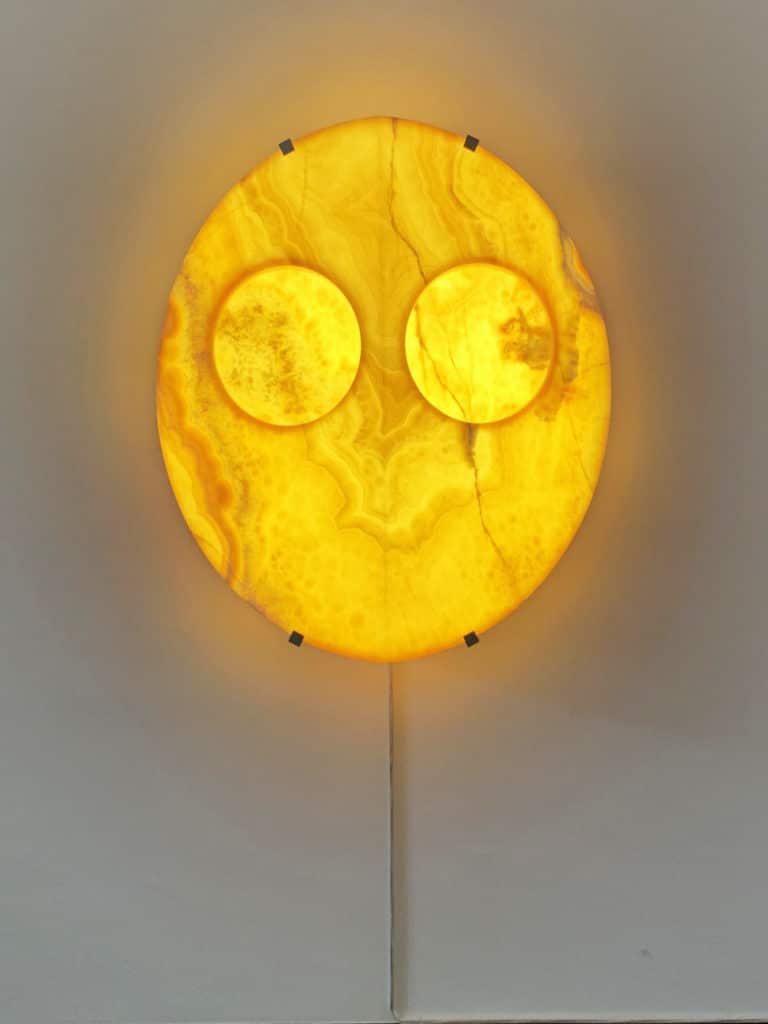
Laurent Grasso, “The Owl of Minerva”, 2018. Parcours Section of Art Basel.
This piece is a luminous onyx sculpture that evokes the simplified silhouette of Minerva’s owl, a well-known attribute of the deity, the Roman goddess of wisdom. Carved in an orange-red stone, it is part of a series commissioned by the Institut de France in Paris, in which historical symbols are reinvested with new meaning. The monumental size of the sculpture creates a shift in scale that heightens the owl’s authority as a strange animist figure.
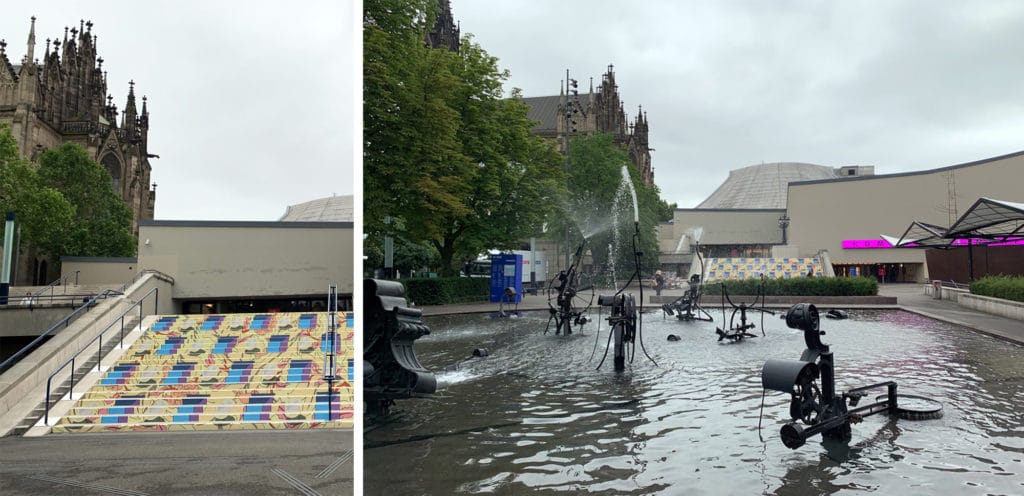
(left) Caitlin Keogh, “Stairs For A Theater”, 2019. (right) Jean Tinguely, “The Carnival Fountain”, 1975-77. Parcours Section of Art Basel.
This is Keogh’s first outdoor piece, which we found quite interesting in relationship to Tinguely’s fountain and its surroundings. Keogh’s graphic imagery incorporates myriad source material. She is interested in how physically breaking up images further complicates them. The installation is an exploration of pictorial stability and an experiential way of displaying a two-dimensional picture. Because visitors appear to be wandering through a painting, Keogh engages with the disjuncture between the architectural, utilitarian agenda of the stairs and the aesthetic language of a superficially applied picture.
Unlimited Section
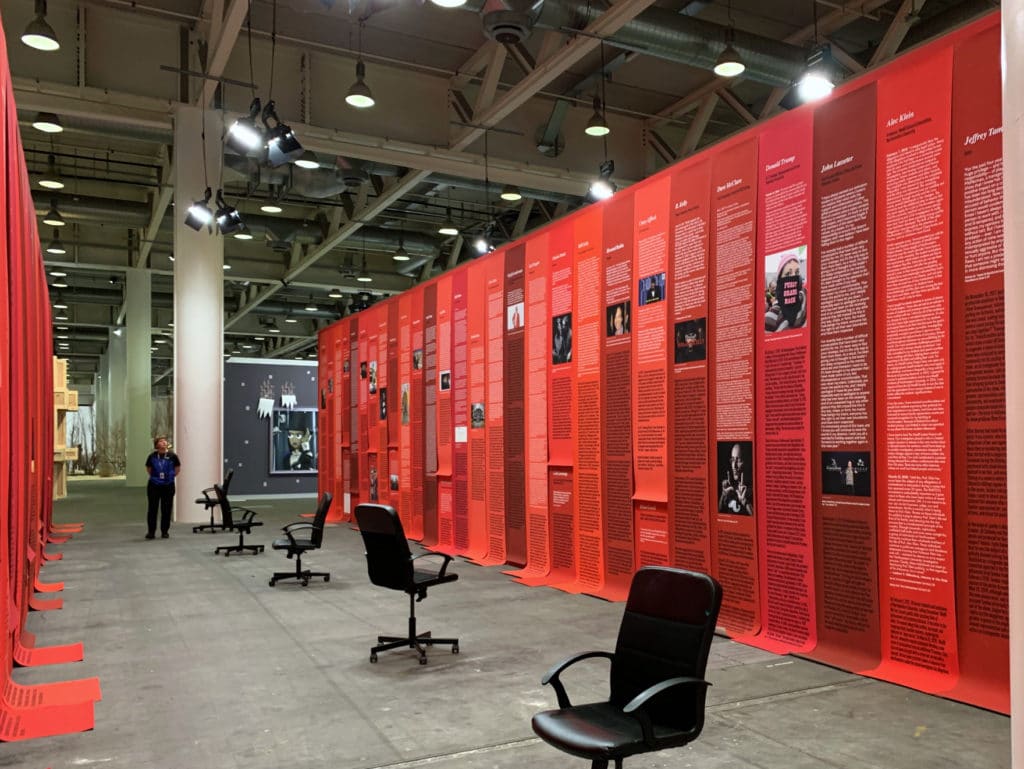
Andrea Bowers, “Open Secret”, 2018. Unlimited Section of Art Basel.
Bowers is an artist and activist whose work foregrounds struggles for justice and human rights. Her research-based, labor-intensive work, in a variety of media, amplifies these voices to create a relationship between the labor of the artist and the labor of activists. Open Secret documents the development of #MeToo and Time’s Up. This iteration of Bower’s archival project includes approximately 200 photographic prints on red backgrounds, each of which lists the name and occupation of an accused person, their public response to the accusations leveled against them, details of the accusations, and legal action or any other resulting action.

Sam Falls, “California Flora (National Forest Condensation Wall, North to South)”, 2017. Unlimited Section of Art Basel.
This body of work depicts the unique and rich collection of national forests in California, where almost every type of landscape environment can be found. Falls traveled to every part of the state and made a painting in each national forest representative of a specific climate using native plants. He works in the forest, site-specifically using collected plants and dry pigments that are then set by the moisture in the air overnight. The work represents a silent testament to nature around the world and the hope for its preservation in a changing political and global climate.
Art Basel Fair

Danh Vō, “Garden with Pigeons in Flight”, 2019. Kurimanzutto booth at Art Basel.
Through a body of personal work inspired also by historical and political events, Danh Vō probes into the inheritance and construction of cultural conflicts, traumas, and values. This installation consists of numerous beeswax candles, made by master artisans in Oaxaca. To produce the candles, the artisans set the wax in the sun for days to bleach their natural yellow color; assemble the candles layer by layer; and, finally, dye them with different densities of carmine. The interaction between the materials and the environment—and their transformation over time—is a constant source of fascination in Danh Vō’s work. The candles allude to the historical lineage of carmine dye extracted from the cochineal insect: a pre-Hispanic technique with a cultural application that survived the Viceroyalty and became an essential part of the New Spanish economy. The ceremonial nature of these candles also evokes the Catholic faith, which is a central subject both in his work.
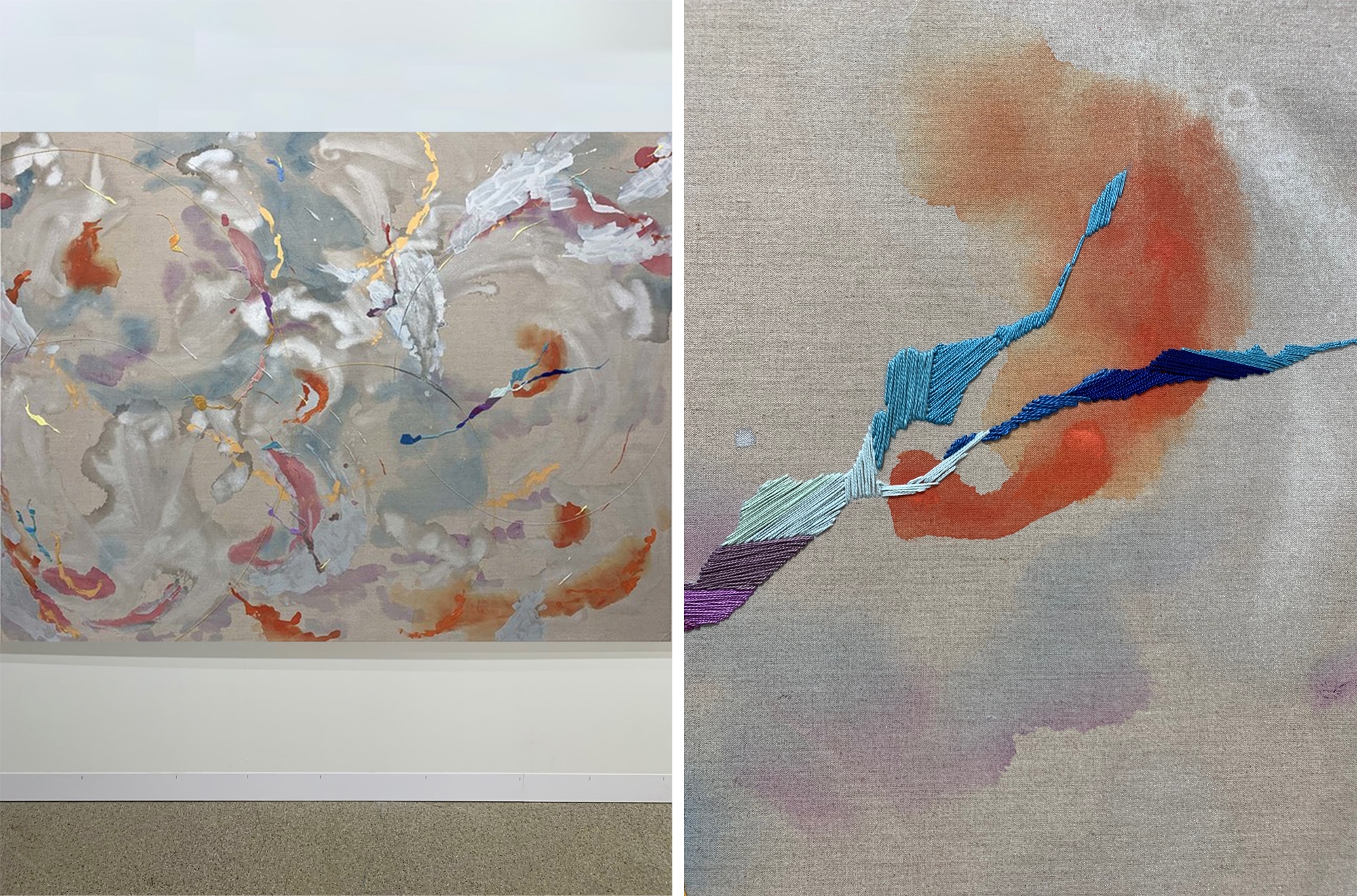
Jessica Rankin, “There and Not There”, 2019. Carlier/Gebauer booth at Art Basel.
Both visual artist and poet, Rankin is known for her expansive embroideries, collages, and watercolors that combine celestial maps and landscapes with fragments of original and found writings. Emerging from an intuitive and unmediated process, her works are marked by vibrant floating color fields. A dynamic interplay of materials ensues, in which embroidery often continues, complicates, or interrupts the painted gesture—at times even imitating the quality and thickness of a brushstroke. Fragments of Rankin’s own writing, as well as the work of other poets and Babylonian creation myths, line the sides of the canvas. Most of her paintings spill over onto the sides of their stretchers.

Maria Bartuszová, “Untitled”, 1987. Alison Jacques Gallery, London booth at Art Basel.
This strong installation consisted of works that were made in plaster, a material that possesses an inherent temporal beauty. Inspired by nature, many of her works appear to take shape as the result of gravity, compressing and expanding to simultaneously reference movement and hesitation. These biomorphic sculptures, in which branches sometimes pass through plaster, are striking in their beauty, their seeming perfection, even, and also, in their vulnerability, precariousness, and fragility.

Hugo McCloud, “Street Walker”, 2019. Susanne Vielmetter Los Angeles booth at Art Basel.
McCloud’s new work is made using plastic merchandise bags to tell the story of human porters, recyclers and labor force workers in India, Asia, Africa and Latin America. The loads that are carried on the subjects backs are true to size and because of that there is a certain respect one must give them. Though their faces are primarily hidden, these people are not unnoticed and their journey through life and how they work with the elements around them is powerful.

Sonia Gomez, “Indo, from Raís series”, 2018. Mendes Wood DM, São Paulo, Brazil booth at Art Basel.
Brazilian artist, Sonia Gomes’ work binds together cultural movements and traditions that are intrinsically linked to memory, identity and the transformative power of creation. Through the use of fabric, thread, found and gifted objects, her multi-dimensional, sometimes biomorphic sculptures stand as insistent placeholders for the absent body. The works are very gestural and resemble human forms. Playing with the potential spiritual combinations that may arise between these elements, her compositions spring to life through a spontaneous and casual practice of deconstructing and re-assembling objects that together evoke the idea of the visceral and the sacred. Through this intuitive process, Gomes honors the previous history and agency of the objects, creating eclectic compositions that are imbued with the rich history of Brazil, as well as the personal history of the artist, her family and her community.
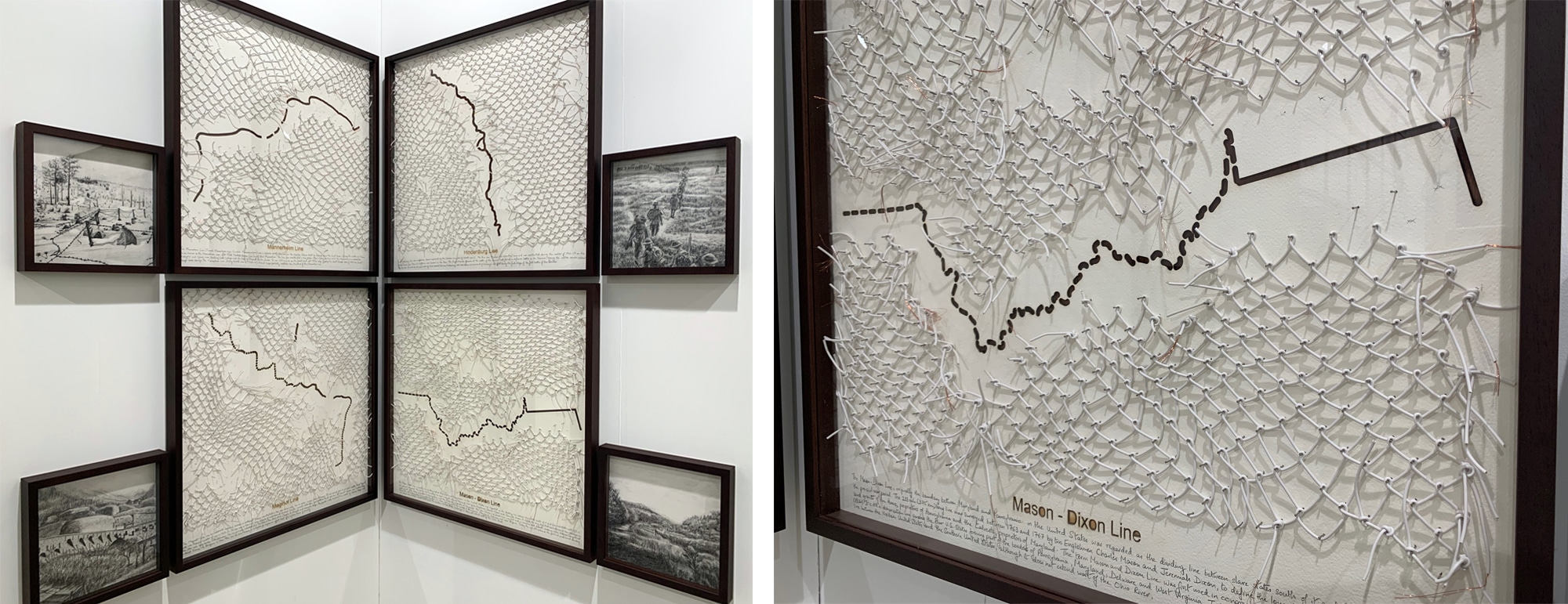
Reena Kallat, “Leaking Lines (diptychs)”, 2019. Chemould Prescott Road booth at Art Basel.
The border, the territory and the map are recurring forms in Kallat’s work that point to broad historical narratives as well as the manner in which human kind have left the imprint of history on geography. In Leaking Lines, Kallat intentionally conflates the lines of international borders and fortifications during wars. Using the diptych format, one part is rendered in charcoal and reveals the factual landscape, while the other is formed using electric wires to form cartographic abstractions that invoke undulating terrain.

Patricia Treib, “Revolve”, 2019. Kate MacGarry booth at Art Basel.
Treib’s bold, translucent, and calligraphic paintings conjure up imagined spaces, appearing in the overlaps and gaps of lush and sensuous surfaces. Treib focuses on compositions from a series of disparate images, delving into how color depicts form and delineates the shadows and spaces in between.

Kader Attia, “Untitled”, 2019 and Liu Wei, “Untitled”, 2019. Lehmann Maupin booth at Art Basel.
Attia’s sculptures offer a poetic yet highly explicit reading of the relationships between Western and non-Western cultures. Through complex investigations of architecture, the human body, literature, and history, Attia demonstrates how individual and cultural identity is constructed within the context of colonial domination and conflict.
Wei’s exploration of urban life stems from the accelerated urbanization afflicting his immediate cityscapes and the instability of a rapidly changing society. Liu Wei generates the patterns and pixels of his paintings through computer software. The paintings are often comprised of densely overlapped layers of vertical or horizontal lines, sometimes in bright, acidic colors, others in more muted color palettes.

Victoria Morton, “Broken Waveform”, 2019. The Modern Institute/Toby Webster Ltd booth at Art Basel.
Morton’s luscious paintings pulse with physical sensation. Unconcerned with traditional painting techniques, Morton allows her actions to circulate, assemblages of color and line tracing shape and space, building surfaces that vibrate with narrative potential and direct energy perhaps influenced by her background as a musician.

Louis Fratino, “Traveling Alone”, 2019. Sikkema Jenkins & Co. booth at Art Basel.
25 year old, Louis Fratino’s draws inspiration from personal experience and photographic source material. Fratino makes paintings and drawings of the male body, including portraits, nudes, and intimate scenes of male couples engaged in activities ranging from the mundane to the graphically sexual. The result is a body of work that is a loving and honest expression of the contemporary gay experience. With great attention to surface and color, features such as an earlobe, belly button, body hair, or the curves and planes of the body are accentuated and stylized in Fratino’s work, complimenting the sensual appeal of his subject.

Bharti Kher, “The watchman”, 2018. Perrotin booth at Art Basel.
Kher’s works displays an unwavering relationship with surrealism, narrative and the nature of things. Her work moves through time using reference as a counterpoint and contradiction as a visual tool. Her chimeras, mythical monsters and allegorical tales combine references that are topical and traditional, political and post-colonial at the same time.

Yukie Ishikawa, “Impermanence–Oboroyo”, 2019. Blum & Poe booth at Art Basel.
Ishikawa began her career in the late 1980s as the Japanese New Painting movement. During this time in Japan, artists began to explore subversive artistic languages of simulacra and appropriation that responded to the zeitgeist of design and advertisement culture during the bubble economy. Ishikawa’s practice is distinct for its conscientious response against the history of Modernist painting and against the monochromatic space found in Minimalist art. The compositions originate from photographs of miscellaneous subject matter she finds in magazines, advertisements, newspapers, and books, which she enlarges, projects, and traces onto the canvas.

Marius Bercea, “Yellow Sparkle”, 2019. François Ghebaly booth at the June in Basel Fair.
Bercea applies color with force and embraces the dynamic between impact and restraint that is necessary to make a painting resonate. His paintings are born out of his travels from his hometown of Cluj, through the rural landscape of California and into Los Angeles. The works are a series of psychological and sensorially-rich encounters that weave through time, space and memory. With iconic motifs recognizable from both Romanian and American cultures, the canvases depict landscapes of color which oscillate between suggestions of utopia and dystopia. The topographical regions of Transylvania and California merge.

Pauline Boudry / Renate Lorenz, “Wig Piece (Entangled Phenomena)”, 2019. Marcelle Alix booth at the Liste Fair.
This wall mounted piece, made largely of artificial hair, by Artist duo Pauline Boudry / Renate Lorenz was a highlight at the Liste Art Fair. The artist team is this years Swiss representative at the Venice Biennale. They turned the Swiss Pavillion into an immersive environment reminiscent of a nightclub. The film installation involves five performers from diverse dance backgrounds experimenting with backward movements as a potential tool for producing alternative forms of resistance and action. The installation in centered around being pushed backwards by recent reactionary backlashes on the queer community.
Watch video here.
Beyeler Foundation

Picasso, “La Vie”, 1903. At the Beyeler Foundation.
The Young Picasso–Blue and Rose Periods at the Beyeler Foundation was devoted to Picasso’s masterpieces of his early Blue and Rose periods from 1901 to 1906. The paintings have a universal evocative power. Matters of existential significance, such as life, love, sexuality, fate, and death, find their embodiment in the subjects.

Rudolf Stingel’s Artist book, “What can painting be today”, 2019, installation. At the Beyeler Foundation.

Rudolf Stingel, “Untitled”, 1992-2019. At the Beyeler Foundation.
Conceptual artist, Rudolph Stingel uses unconventional materials in his work. One of the stand-out works at the Beyeler Foundation, was the orange carpet installation, originally shown in 1991 at Daniel Newberg Gallery and again, later at the Venice Biennale. The interactive work involves the participant in the question of what constitutes a painting.
Venice
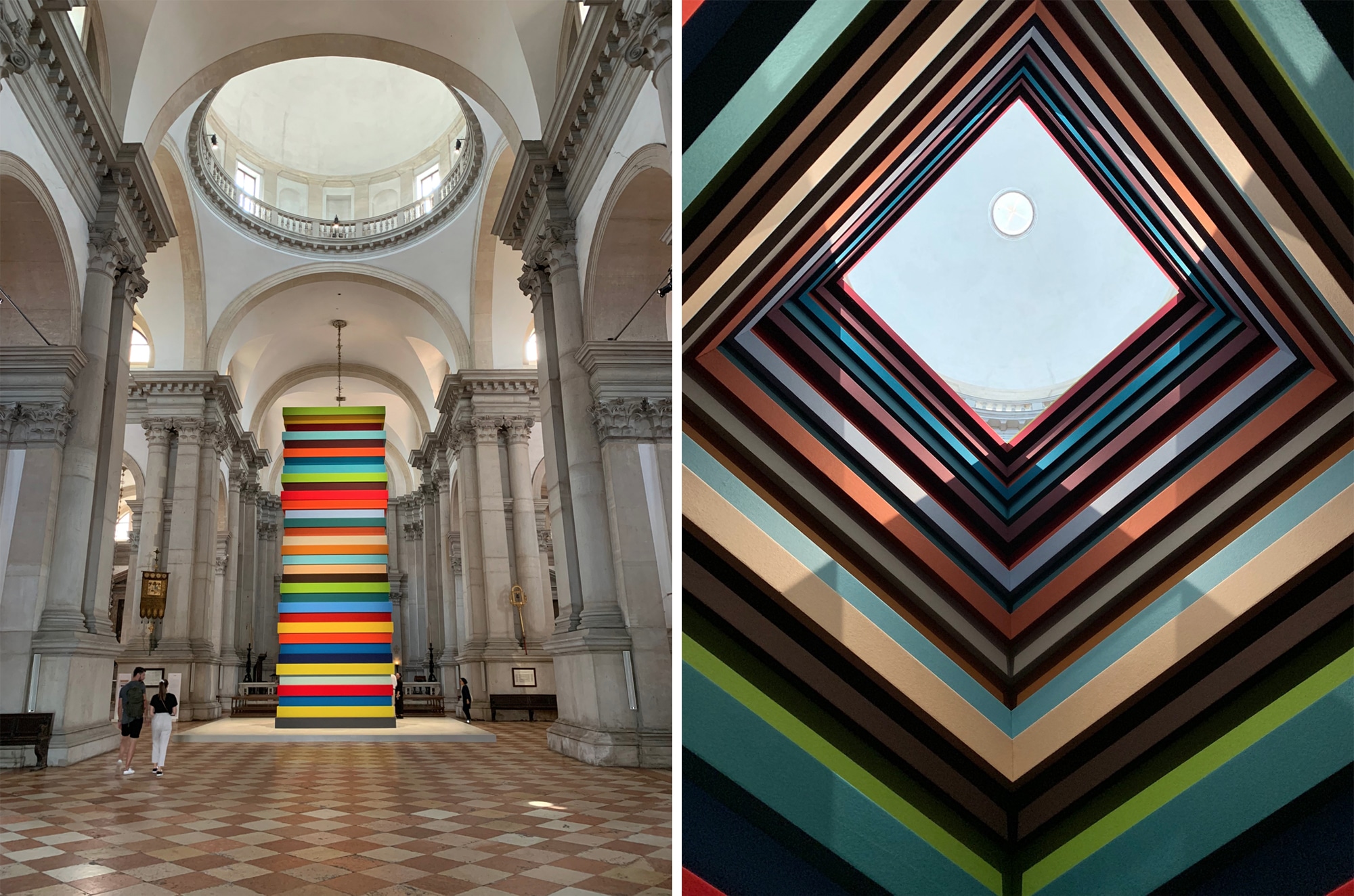
Sean Scully, “Opulent Ascension”, 2019. At Abbazia di San Giorgio Maggiore, Venice.
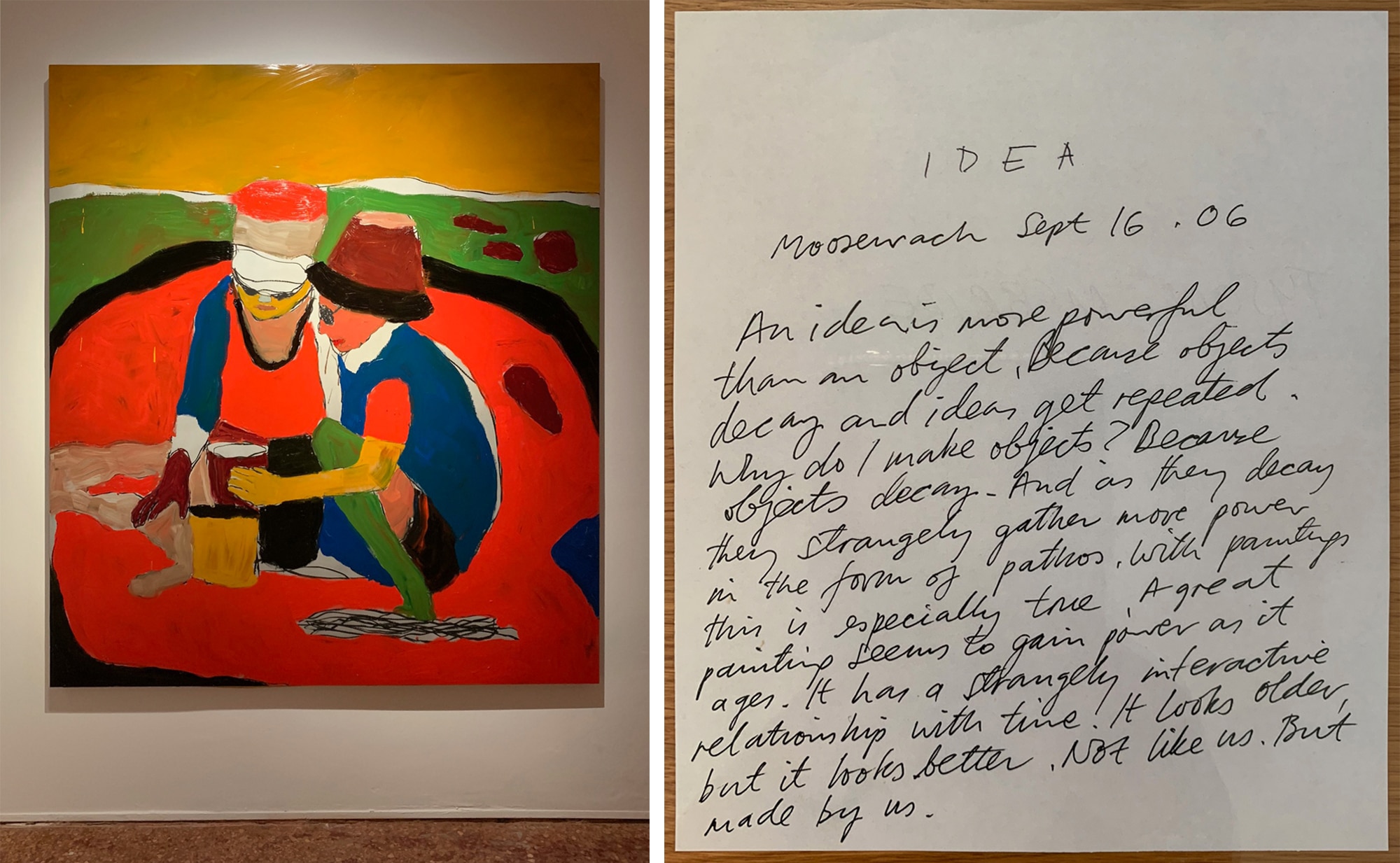
Sean Scully, (left) “Madonna Triptych”, 2018. (right) “Idea”, artist notes, 2016. At Abbazia di San Giorgio Maggiore, Venice.
Irish artist, Sean Scully transformed the 16th-century Benedictine church into a visual and spiritual meditation on the human condition. The 10-meter high sculpture, the tallest piece he has ever made, rises toward the basilica’s dome. Scully’s unique vocabulary of horizontal and vertical stripes, combined with his recent return to figuration (in Madonna Triptych), brings together an interplay of artistic creation and architectural grandeur. Scully’s thoughtful notes incorporated in the exhibition offer a window into his philosophical approach to art and life.
Punta Della Dogana
A highlight in Venice was Luogo e Segni (Place and Signs) exhibition at Punta della Dogana. The writings of artist Etel Adnan – focused on the elusive elements in nature – is the common thread in this exhibition.
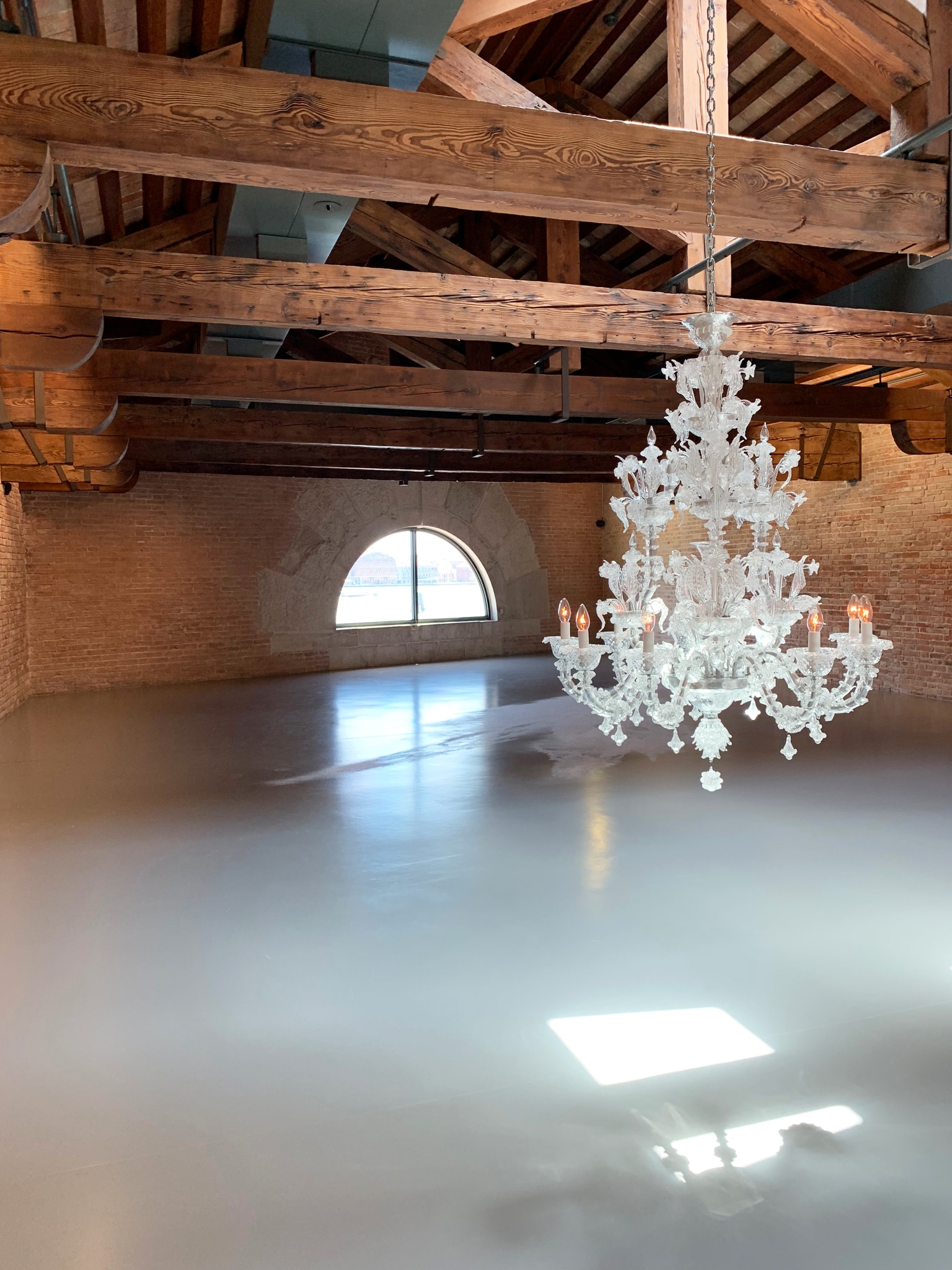
Ann Veronica Janssens, “Untitled (White Glitter)”, 2016 and Cerith Wyn Evans, “We are in Yucatan and every unpredicted thing”, 2012/2014. Included in “Luogo e Segni” exhibition at Punta Della Dogana, Venice.
Janssens’ work, consisting of a dusting of glitter on the floor, questions the nature of light and its materiality. A body without a body, this at once indistinct and specific form seems, depending on the direction of the light, to float, move and change on the surface of the ground. She takes us to the heart of complex phenomena of perception where sensation, imagination, and memory are combined.
Deeply influenced by literature, music, and philosophy, Evans’ works combine new technology and craftsmanship while exploiting the potential of language. His chandeliers flash to the rhythm of a transcription of literary and philosophical texts in Morse code. We are in Yucatan and every unpredicted thing lights up almost imperceptibly to the rhythm of a soundtrack composed and recorded by Evans.

Etel Adnan, “DHKIR”, 1978. Included in “Luogo e Segni” exhibition at Punta Della Dogana, Venice.
For Etel Adnan, writing and painting are two modes of expression of one and the same language. Writing and drawing are intermixed. Her works are inspired by the cities and landscapes she has discovered and traversed.
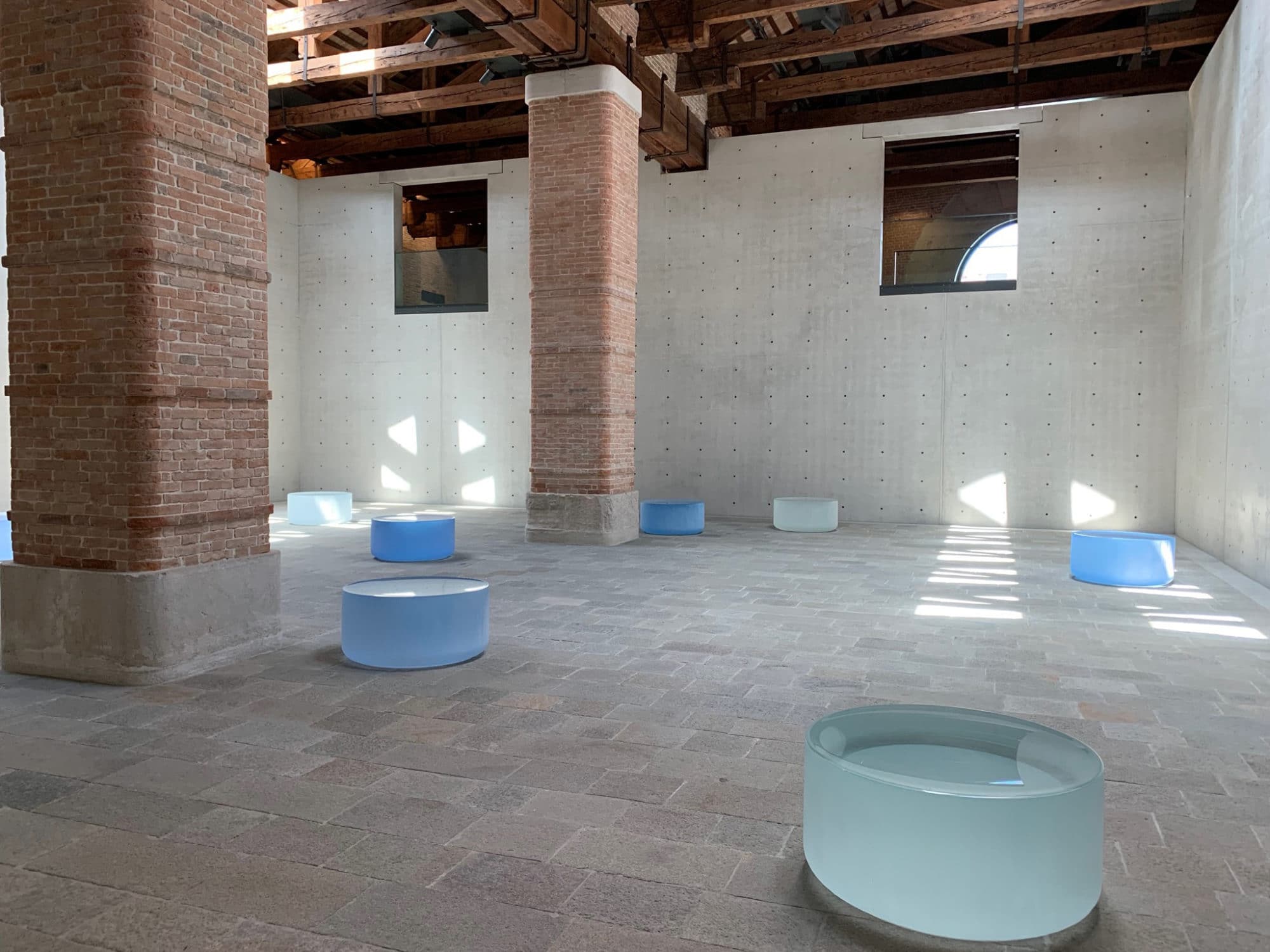
Roni Horn, “Well and Truly”, 2009-2010. At Punta Della Dogana, Venice.
Water, due to its constant movement, its metaphysical nature, and its potential ability to take on a range of meanings, has been a major theme in Horn’s work. In this installation, water is represented in the petrified form of ten blocks of glass in different shades of blue, blue-green, light gray, and white. Being able to observe the translucence of the glass, it’s ambiguous depth, and the way it changes incessantly under natural light was spectacular.
Palazzo Grassi
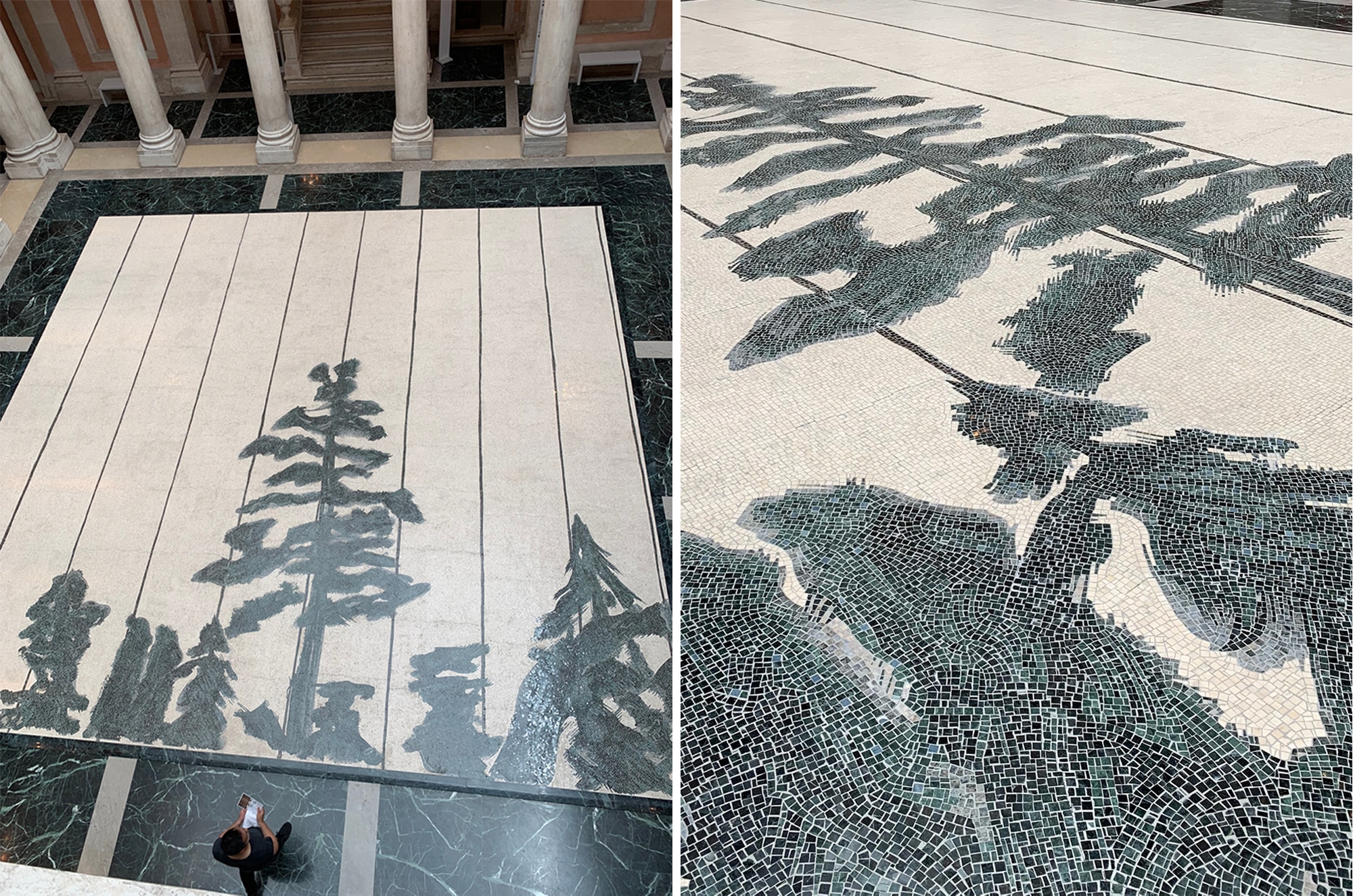
Luc Tuymans, “La Pelle”, 2019. At Palazzo Grassi.

Luc Tuymans, “Turtle”, 2007. At Palazzo Grassi.
Tuymans has been dedicated to figurative painting since the mid 1980s and has contributed throughout his career to the rebirth of this genre in contemporary art. His works focus on the gap between historical events and the images circulated through the media that often inadequately communicate the reality of the event.
Venice Biennale

Rugilė Barzdžiukaitė, Vaiva Grainytė and Lina Lapelytė, “Sun & Sea (Marina)”, 2019. Lithuanian Pavilion at the Venice Biennale.

“Wealthy Mommy’s Song”, lyrics from “Sun & Sea (Marina)”, 2019. Lithuanian Pavilion at the Venice Biennale.
The artist collaborative that created “Sun & Sea (Marina) won this year’s Golden Lion award. The opera, set entirely indoors and viewed from above featured a sandy beach, illuminated by an artificial sun and populated by actors mimicking a typical beach scene. The lyrics reveal a different story; one that comments on the mundane and even destructive experience of our lack of consciousness about human impact on the planet.

Shilpa Gupta, “For, in your tongue, I cannot fit”, 2017-18.”May You Live in Interesting Times” exhibition at the Venice Biennale.
This sound installation addresses the violence of censorship through a symphony of recorded voices which speak or sing the verses of 100 poets imprisoned for their work or political positions, from the 7th century to today. The recitations are in multiple languages and create a chorus of disembodied voices.

Njideka Akunyili Crosby, “May You Live in Interesting Times”.”May You Live in Interesting Times” exhibition at the Venice Biennale.
The paintings of Njideka Akunyili Crosby reflect her experience as a member of the contemporary Nigerian diaspora, depicting a specific cultural and national identity that is unfamiliar to many, though instantly recognizable to those who share her cultural history. Her paintings usually feature herself and her family and many are drawn from her memories of Nigeria.

Suki Seokyeong Kang, “Land Land Strand, 2016-2019.”May You Live in Interesting Times” exhibition at the Venice Biennale.
The installation is activated through a series of movements inspired by the Korean Spring Oriole Dance. Kang appropriates the formal language of the grid used in traditional Korean musical notation as a spatial and social structuring device, which were derived from the artist’s own torso. The artist is interested in preserving traditional Korean craft traditions.

Otobong Nkanga, “Veins Aligned”, 2018. “May You Live in Interesting Times” exhibition at the Venice Biennale.
The idea of landscape as a body is described in this 70 plus foot long installation. The fleshy toned glass and marble sculpture resembles a river with the reflection of chemically polluted clouds. Nkanga won the Sharjah Biennial Prize for her ongoing exploration into the politics of land, body and time.

Ulrike Müller, “Container”, 2018-2019.”May You Live in Interesting Times” exhibition at the Venice Biennale.
Ulrike Müller works across several media to deploy a graphic and rigorous formalism that is charged with feminist and queer possibilities. She creates meticulous surfaces that invite an intimate looking. Her rugs were made by a workshop in Oaxaza, Mexico on a pedal loom. The high-heel shoe motif refers to sources including vernacular signage and Andy Warhol’s shoe drawings.
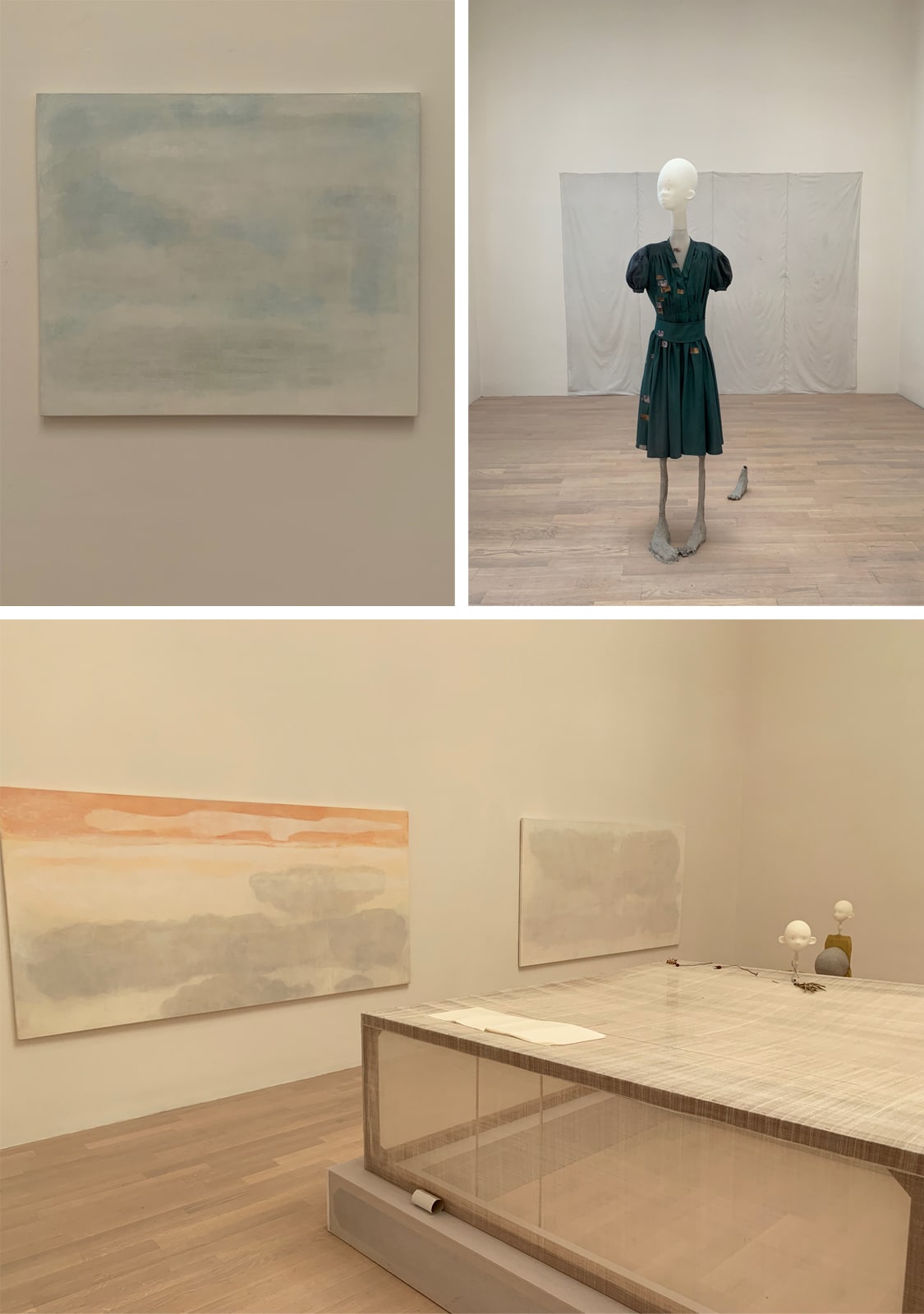
Cathy Wilkes at The British Council booth at the Venice Biennale.
Cathy Wilkes’ mysterious and layered installation included painting, sculpture, and found objects – all hinting at meaning but leaving the viewer without any specificity. Her work recalls inchoate visions of interiors and places of loss, and meditates on the nature of love and the coexistence of life and death.

Zhanna Kadyrova, “Market”, 2017-2019. “May You Live in Interesting Times” exhibition at the Venice Biennale.
Kadyrova experiments with readymade forms and materials that reference specific histories. She often uses cheap tiling for mosaic, combined with heavyweight construction materials such as concrete and cement. For Market, a food stall equipped with everything a street trader needs, she makes sausages and salamis from concrete and natural stone, and fashions fruit and vegetables in chunky mosaic.

El Anatsui, “Ghana Freedom”, 2019. The Ghanian Pavilion at the Venice Biennale.
Modelled on traditional Gurunsi earth houses, the Ghana pavilion comprises a series of interconnected oval-shaped galleries topped by a wooden roof. The exhibition and explores the legacy and trajectories of that regained freedom through the work of six artists spanning three generations. El Anatsui’s work consists of beautiful tapestries in which earthy browns, yellows, and reds alternate and evoke intricate mud paintings found in Gurunsi dwellings. The tapestries are made out from a large number of small fragments of different materials, especially aluminum from used crown caps and cans, to form hundreds or thousands of tiny tesserae which form geographical maps of imaginary territories.

Eva Rothschild, “The Shrinking Universe”, 2019. Ireland Pavilion at the Venice Biennale.
Through her diverse use of materials and sculptural formats, Rothschild creates immersive installations that allows the public to be both viewer and participant. The work demonstrates a great awareness of the modernist tradition while maintaining its own distinctive sculptural language. Her works also engage with signifiers and objects from her surrounding urban environment, and the eternal forms of geometry and classicism. Her sense of materials, scale, monumentality, color and line reflect a refined aesthetic sensibility that redeploys and subverts familiar sculptural formats.
Galleria Continua San Gimignano

Michelangelo Pistoletto & Pascale Marthine Tayou. “Una cosa non esclude l’altra – One thing doesn’t exclude the other”, 2019. At Galleria Continua San Gimignano.

Pascale Marthine Tayou, “Daily Life”, 2019. At Galleria Continua San Gimignano.
Michelangelo Pistoletto and Pascale Marthine Tayou create work which = is presented as a research in continuous evolution and expansion, intended to restore the contact between the artistic experience and the external world. In Pistoletto’s multi-disciplinary practice, there is a dialogue in which multiple voices take part, as his aesthetic is based on a form of relationship and participation which goes beyond the confines of the work. Tayou’s work on the other hand seeks to redefine postcolonial issues through the European experience, and to reflect on questions such as immigration, the role of the individual, and national and cultural identity.
Castello Di Ama
Located in the Chianti region of Tuscany in a 12th Century hamlet, Castello Di Ama is home to an ongoing private collection including some of the world’s most well known artists. Each work is site specific, conceived of and realized in concert with the land, it’s history and spirit.
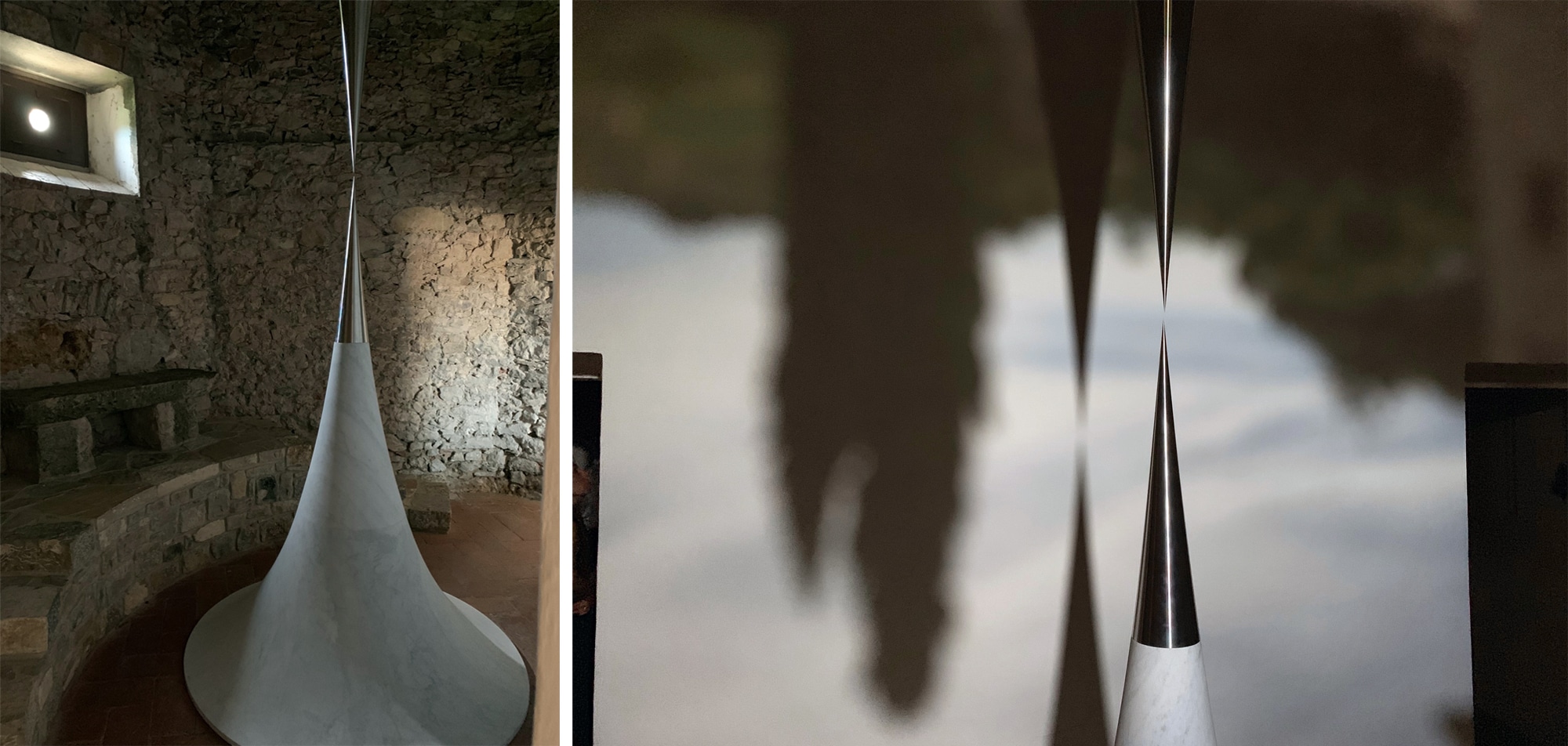
Hiroshi Sugimoto, “Confession of zero”, 2014. At Castello Di Ama, Siena.
Sugimoto gives zero, a number that denotes the existence of absence, a shape in this installation. The realm of zero lies in that narrow gap between the two points of the mathematical model he created, facing off against each other in the silence of a the sacristy of a small 18th-century chapel at Castello di Ama. Sugimoto also turned the space into a camera obscura which inverts images from the outside and projects them over the sculpture.

Anish Kapoor, “Aima”, 2004. At Castello di Ama, Siena.
One of the constants in the work of Anish Kapoor is the creation of openings in the earth’s crust. In the chapel at Castello di Ama, a bright circle opens in the centre of the paving which resembles fire and light.

Kendell Geers, “Revolution/Love”, 2003. At Castello di Ama, Siena.
The work was conceived for a wine cellar which emphasizes on the one hand the alchemic transformation of winemaking and, on the other, the everyday revolution we all engage in at home. The text is set in a room evocative of a Romanic crypt and is red, like wine and also, blood.
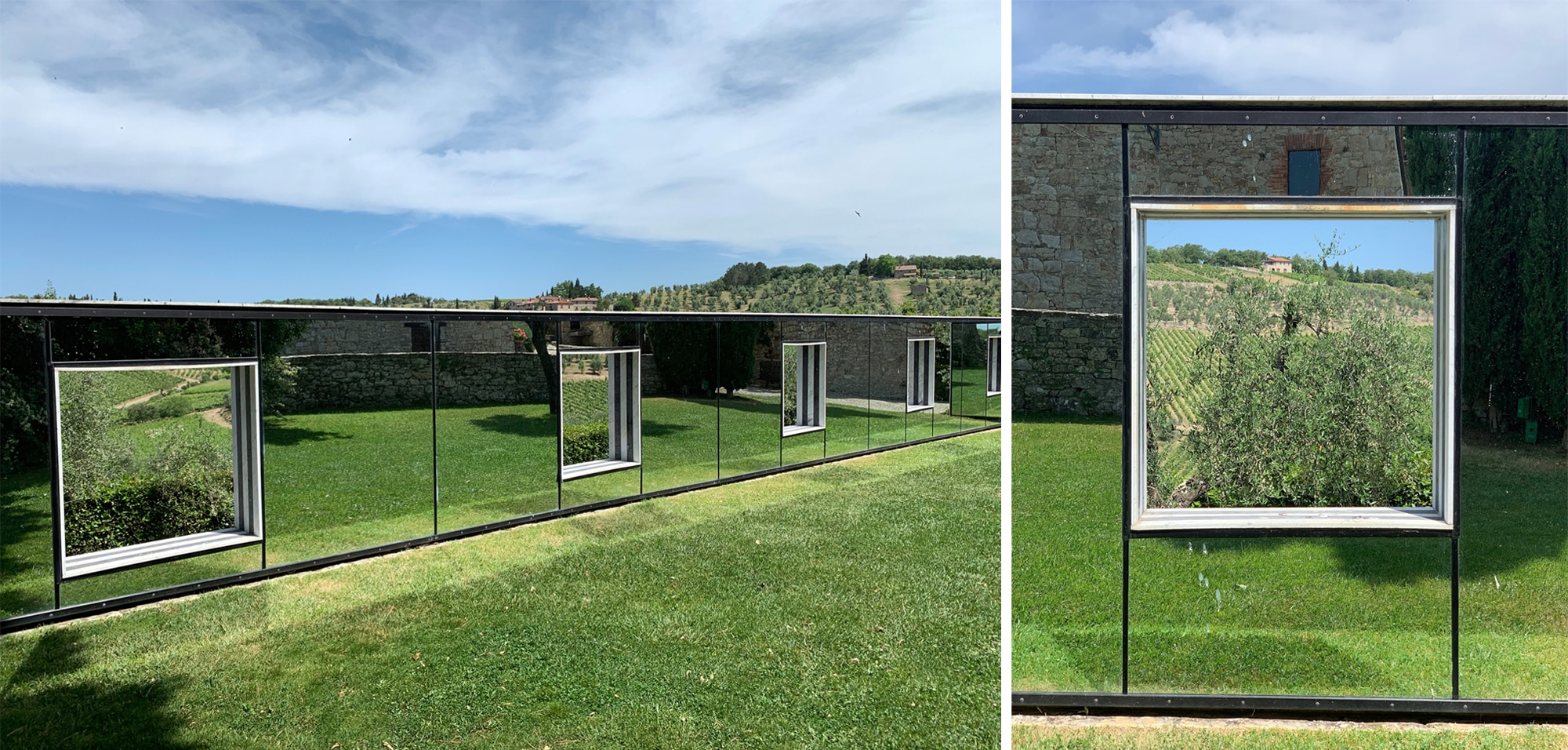
Daniel Buren, “Sulle vigne: punti di vista”, 2001. At Castello Di Ama, Siena.
Buren’s 25 metres long and two metres high wall was built to purposely block the view of the surrounding countryside, but at the same time to open it up in a very particular way. The wall is dotted with square windows that emphasize the landscape of the valley by framing it, thereby referencing the tradition of landscape painting, and also the equally familiar notion of painting as a window opened onto reality.

Lee Ufan, “Topos (Excavated)”, 2016. At Castello di Ama, Siena.
Lee transformed one of the wine cellars into an immersive installation. Within a stone vault, Lee created a dramatically lit mise en scène featuring a wall drawing and a floor painting. The wall displays the outline of a form drawn in charcoal over a white gesso ground, suggesting the trace of something that has faded over time. On the floor, a single form painted over a rough concrete ground is framed by a gravel walk of marble. As the subtitle implies, this floor painting looks as if it has been discovered rather than made, embodying the artist’s belief that “art is based on a previous encounter” and that artistic expression is in reality a “re-presentation” of that encounter. The work crystallizes the full breadth and reach of Lee’s searching philosophical investigations into perception, identity, memory, and the passage of time.
Paris
Centre Pompidou

Bernard Frize, “Without Remorse”, 2019. At Centre Pompidou.

Bernard Frize, ” LedZ”, 2018. At Centre Pompidou.
Frize paints in a single movement and without further alterations. His great technical mastery and efficiency is prevalent in the work. The exhibition brings the viewer into the very act of creation, revealing which strategies and intellectual challenges underlie Frize’s works.
The Foundation Louis Vuitton
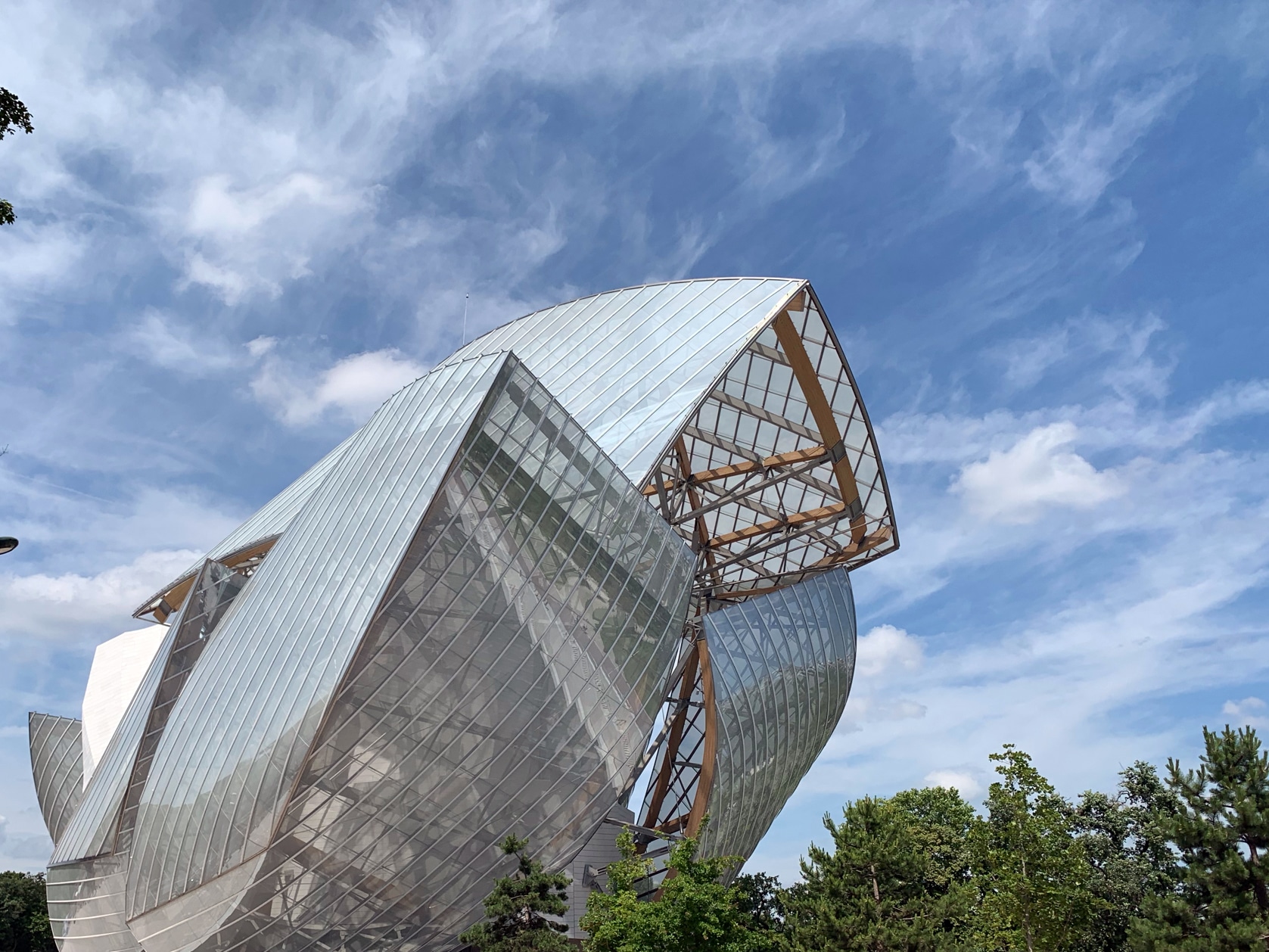
View of The Foundation Louis Vuitton, Paris.

Joan Mitchell, installation view. At The Foundation Louis Vuitton, Paris.
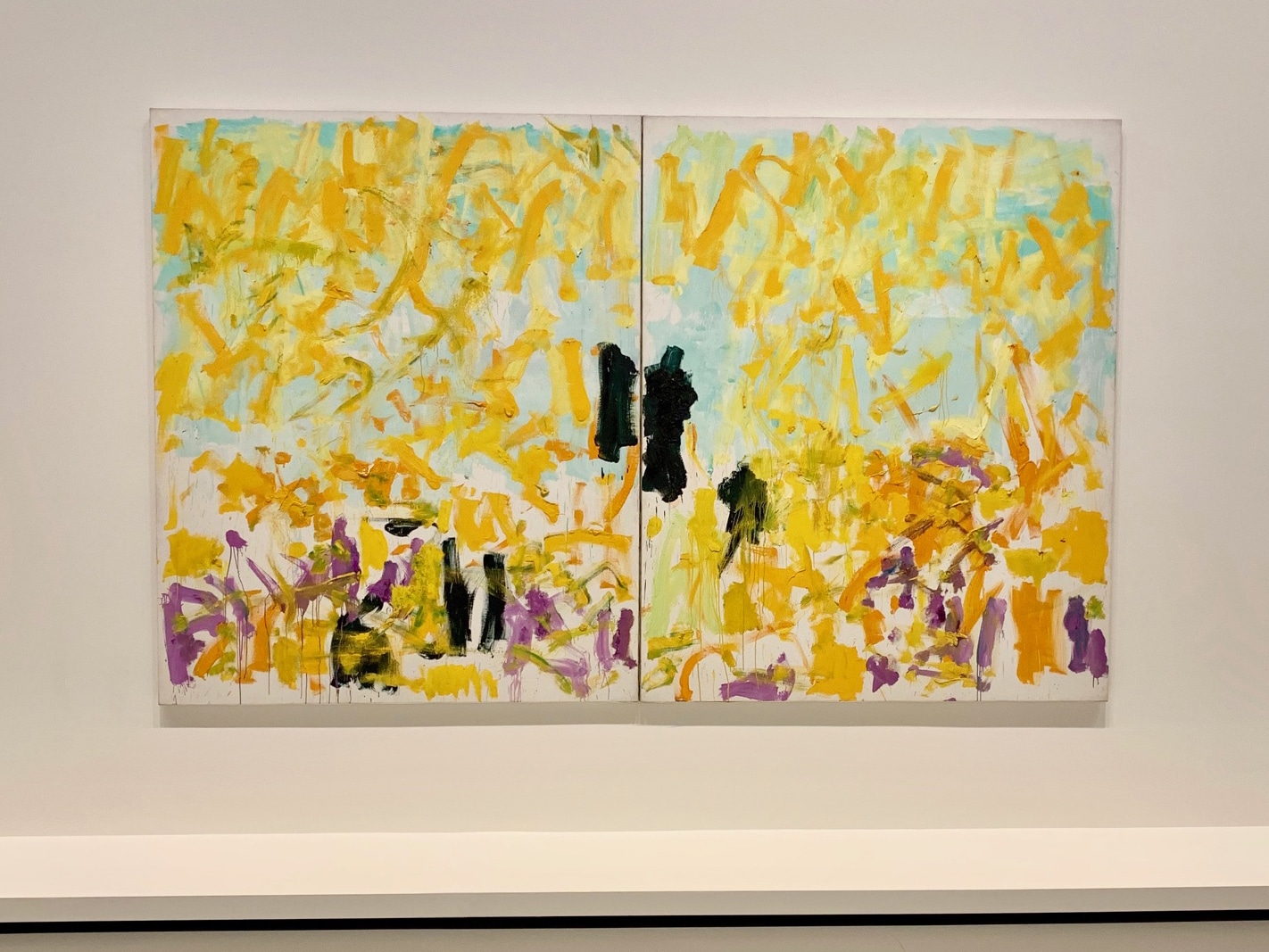
Joan Mitchell, “Cypress”, 1980. At The Foundation Louis Vuitton, Paris.
Part of the exhibition, The Collection of The Foundation: A Vision for Painting, these Joan Mitchell paintings are remarkable. Her recurrent use of panel painting enabled her to control the composition of her paintings in which strident, overlapping colors create tension, while contributing to an overall harmony.